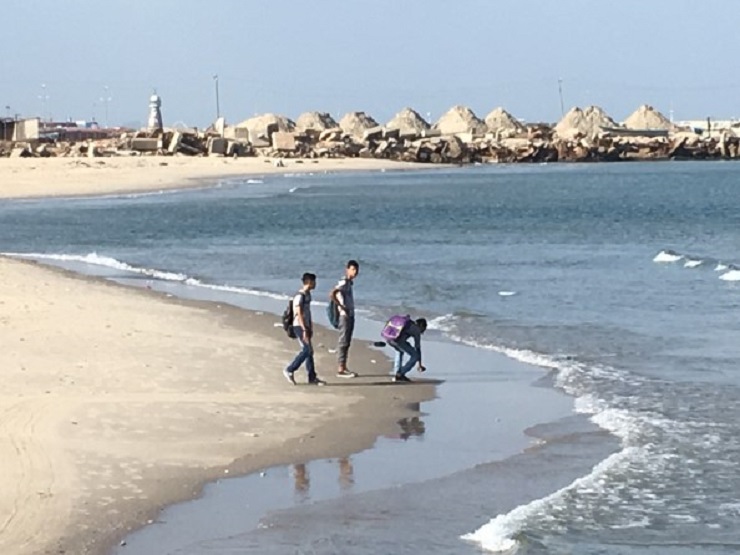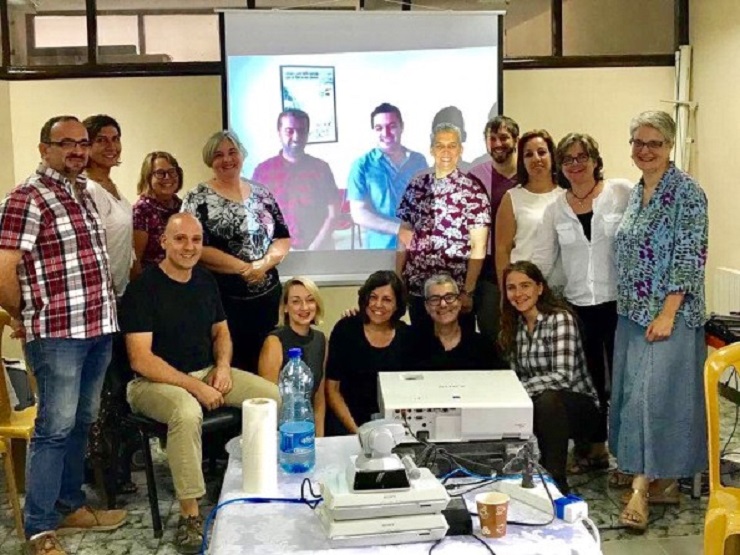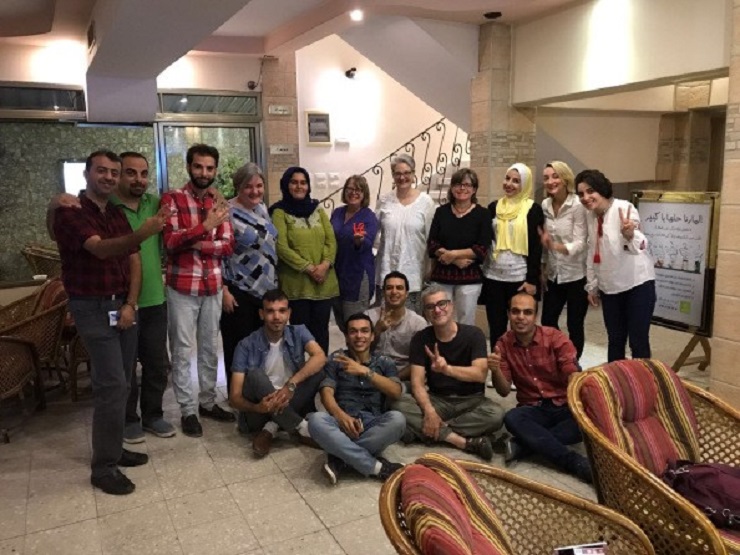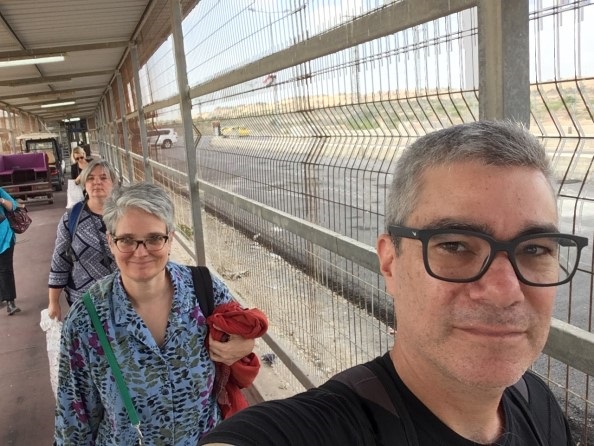
Photo Credit: Brant Rosen Brant Rosen
I’ve written a great deal about Gaza for over ten years but until this past week, I haven’t had the opportunity to visit in person. I’m enormously grateful for the opportunity to experience Gaza as a real living, breathing community and I’m returning home all the more committed to the movement to free Gaza from Israel’s crushing blockade – now eleven years underway with no end in sight.
For the past ten days, I’ve been attending strategic planning meetings with staff colleagues of the American Friends Service Committee (AFSC) to sharpen our vision for our Israel/Palestine programs in the US, Israel, the West Bank and Gaza. We began with three days of meetings in Ramallah – with our staff members in Gaza joining us via Skype. Following these meetings, six of us spent two days in Gaza, hosted by the two full-time members of the Gaza staff: Ali and Firas.

It’s extremely rare for Americans to receive permission from Israel to enter Gaza through the Erez Crossing. Permits are generally issued only for journalists and staff people of registered international NGOs. Though I was technically allowed to enter Gaza as an AFSC staff member, I wasn’t 100% sure it would really happen until the moment I was actually waved through the crossing by the solider at Passport Control in Erez.
Quakers have a long history in Israel/Palestine dating back to before the founding of the state of Israel. The Ramallah Friends School for Girls was founded in 1889, and their School for Boys in 1901. The two schools subsequently merged into one; now well into the 21st century Ramallah Friends remains an important and venerable Palestinian educational institution. (The former head of the school, Joyce Ajlouny, was recently appointed AFSC’s General Secretary.)
AFSC has a particularly significant connection to Gaza. In 1949, immediately following Israel’s founding and the start of the Palestinian refugee crisis, the organization was asked by the UN to organize relief efforts for refugees in the Gaza Strip. AFSC agreed to support refugees during that time believing it would be temporary support. When it became clear there was no plan to send the refugees to return home, AFSC became clear that we could not in good conscience build up more permanent refugee camps – that there was a political solution to the refugee crisis then (as there is now). The United Nations Relief Works Agency started its operations there a year later. Since that time, AFSC has retained its programmatic presence throughout the Israel and the Occupied Territories.
Up until relatively recently, AFSC’s Palestine youth program focused largely on Public Achievement, seeking to strengthen the civic ties of youth to their communities. Our current program, Palestinian Youth Together for Change (PYTC) is a more ambitious project, working to combat Palestinian geographical, social and cultural fragmentation in Israel, the West Bank and Gaza. It’s difficult to overestimate the devastating impact of this fragmentation – particularly on Palestinian youth who are growing up with increasing separation from one another. This isolation is most keenly felt of course, by the youth of Gaza who are literally imprisoned by Israel inside a small 140 square mile strip of land.
When we met the Palestinian youth in Gaza who participated in the PYTC program, they spoke powerfully about their experiences growing up with a strong sense of Palestinian identity while isolated from their peers in Israel and the West Bank. This particularly hit home for me when I heard one young woman speak of entering into Israel through the Erez Crossing for the first time to travel to the West Bank for meetings with her fellow participants. She was eighteen years old and had never seen an Israeli Jew in person in her life. Up until that time, she said, she had only seen them as “helicopters, planes and bombs.” Needless to say, this contrasted dramatically from the experience of her West Bank peers, who encountered Israeli soldiers as a very real, everyday presence in the streets and at checkpoints.

It’s also important to bear in mind that this isolation is not a “humanitarian” issue that can be fully addressed by greater NGO and civil society investment. Rather it is the result of very real and very intentional policies promulgated by Israel to purposefully divide and weaken Palestinian society. By the same token, the PYTC program is not merely a youth service project – its ultimate goal is to strengthen Palestinian identity in order to counter the brutal and unjust occupation of their people. In this regard this program is connected in important ways to AFSC programs in the US that promote “co-resistance:” initiatives that support the Palestinian civil society call for Boycott, Divestment and Sanctions, advocate for Palestinian children held by Israel in military detention and educate the public about the devastating costs of the Gaza blockade.
There’s so much more I could write about my experiences in Gaza. As I prepared to head back to the States, I struggled to give voice to the myriad of emotions that were flooding through me. At the moment, I’m thinking particularly of Ali and Firas, our Gaza staff members, who were not only gracious and wonderful hosts (although they were entirely that); but also talented and visionary organizers who teach us a great deal about how to do this work effectively in the most extreme of circumstances.
Even under the brutality of Israel’s blockade, we could not help but be struck by the beauty of this place and the dignity of its people and culture (which includes, I hasten to add, the deliciousness of its cuisine). As it happened, our visit occurred immediately after the beginning of reconciliation talks between Hamas and the Palestinian Authority, brokered by the Egyptian government. Most of the Palestinians in Gaza we spoke to expressed a guarded sense of hope that it might result in some easement of the blockade – particularly in regards to freedom of movement, drinkable water and electrical service. Of course this optimism occurs within a constant context of isolation and vulnerability. The next Israeli military assault is altogether possible at any moment – and every Palestinian in Gaza must contend with this horrible reality every moment of every day.
My staff colleagues will be writing more about these moments and I will be sure to share their posts here. For now, I’ll end on a note of gratitude: to AFSC for giving me the opportunity to participate in this sacred work; to our gracious hosts in East Jerusalem, Ramallah and Gaza; and to my US staff colleagues who are true travel companions in more ways than one.
I took the picture at the top of this post during our final hours in Gaza. As we debriefed on a beautiful morning over coffee at a seaside cafe, three young boys who likely should have been in school came down to the beach to hang out and have fun together. The loveliness of the moment was both very real and very illusory. There was no mistaking the beauty of the place and people with whom we were sharing this moment. At the same time, however, we were aware that we were in the affluent tourist part of town and that we were privileged enough to soon be leaving Gaza to travel without restriction. We were also well aware that not far from the place these boys were standing, Ismail Mohammed Bakr (9), Zakaria Ahed Bakr (10), Ahed Atef Bakr (10) and Mohamed Ramez Bakr (11) were murdered by Israeli naval fire while they played soccer on the beach on July 16, 2014.
There can be no illusions where Gaza is concerned. As I leave for home, I’m more convinced than ever that we are all complicit in this cruelty – and that we are the ones who must end it.



More Resources:
Visit AFSC's Gaza Unlocked website
Take action: Urge Congress to take action to end the blockade